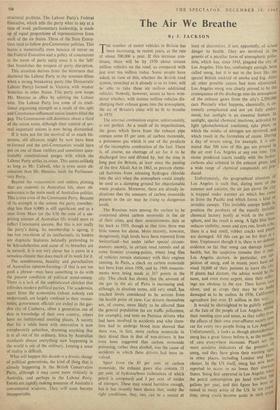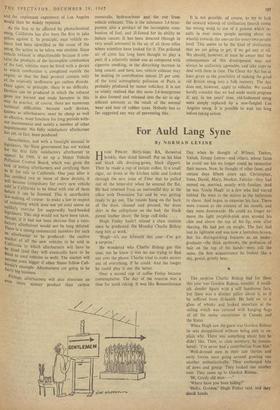The Air We Breathe
By J. JACKSON THE number of motor vehicles in Britain has been increasing, in recent years, at the rate of about 700,000 a year. If this increase con- tinues, there will be by 1970 about sixteen
million vehicles on the road, as compared with just over ten million today. Some people have asked, in view of this, whether the British road system, stretched as it already is to its limit, will be able to take these six million additional vehicles. Nobody, however, seems to have won- dered whether, with sixteen million vehicles dis- charging their exhaust gases into the atmosphere, the air of Britain's cities will be fit to breathe in 1970.
The internal combustion engine, unfort unately, _ is not perfect. As a result of its imperfections, the gases which leave from the exhaust pipe contain some 85 per cent. of carbon monoxide, a poisonous gas which is one of the products of the incomplete combustion of the fuel. There is, of course, no shortage of air for it to be discharged into and diluted by, but the time is long past (in Britain, at least since the passing of the first Alkali Act in 1863, to prevent chemi- cal factories from releasing hydrogen chloride into the air) when the atmosphere could simply be used as a dumping ground for objectionable waste products. Moreover, there are already in- dications that the amounts of carbon monoxide present in the air may be rising to dangerous levels.
The Russians were among the earliest• to be concerned about carbon monoxide in the air
of their cities, and their measurements date as far back as 1935, though at that time there was little reason for alarm. More recently, however, dangerously high levels have been reported from
Switzerland—but under rather special circum- stances; namely, in certain road, tunnels and at
some frontier crossing-points, where long files of vehicles remain stationary with their engines running. In Paris, a check on carbon monoxide has been kept since 1956, and by 1960 measure- ments were being made at 317 points in the city. This check has shown that the amount of the gas in the air of Paris is increasing and, although, in absolute terms, still very small, has reached levels considered to be serious from the health point of view. Car drivers themselves are, of course, more likely to be affected than the general population (as are traffic policemen, for example), and tests on Parisian drivers who had been involved in accidents and who there- fore had to undergo blood tests showed that there was, in fact, more carbon monoxide in their blood than in that of non-drivers. It has even been suggested that carbon monoxide poisoning, rather than alcohol, was the cause of accidents in which these drivers had been in- volved.
Apart from the 85 per cent. of carbon monoxide, the exhaust gases also contain 11
per cent, of hydrocarbons (substances of which petrol is composed) and 3 per cent. of oxides
of nitrogen. These may sound harmless enough, but it has recently been shown that, under the right conditions, they, too, can be a source at least of discomfort, if not;apparently, of actual danger to health. They are involved in the genesis of a peculiar form of atmospheric pollu- tion, which has, since 1943, plagued the city of Los Angeles. This has, confusingly enough, been called smog, but it is not in the least like the special British cocktail of smoke and fog. After all other possible causes had been eliminated, Los Angeles smog was clearly proved to be the consequence of the discharge into the atmosphere of the exhaust gases from the city's 2,500,000 cars. Precisely what happens, chemically, is ex- tremely complicated and not yet fully under- stood, but sunlight is an essential feature. In sunlight, special chemical reactions, activated by light (photochemical reactions), take place, in
which the oxides of nitrogen are involved, and which result in the formation of ozone. During a day of severe smog, for example, it is esti- mated that 500 tons of this gas are present in the air over Los Angeles at any one time. The
ozone produced reacts readily with the hydro- carbons also released in the exhaust gases, and a wide range of chemical compounds are Pro- duced. Unfortunately, the geographical situation of Los Angeles is such that, during most of the
summer and autumn, the air just above the city. is trapped under warmer air which has come in from the Pacific and which forms a kind of invisible canopy. This invisible canopy holds in
position the products of the equally invisible chemical factory busily at wbrk in the atin°- sphere, and the result is smog. A light blue bale reduces visibility, noses and eyes run, heads ache, there is a bad smell, rubber cracks and Plants are damaged. All this can go on for days at a
time. Unpleasant though it is, there is no definite evidence so far that smog can damage human
health, but, the suspicion remains that it maY* Los Angeles doctors, in particular, are Os- picious of smog, and in recent years have td,-, vised 10,000 of their patients to leave the ow If plants had doctors, the advice would be the same, and even more urgent, since their suffer" ings are obvious to the eye. Their leaves torn silver, and as crops they may be so bad.1„31 damaged as to be useless. In 1956, CaliforinaP agriculture lost over $5 million in this It would be shortsighted to be guiltily an11, at the fate of the people of Los Angeles, wil/1"co' their running eyes and noses, as they suffer the effects of their own over-affluent societY car for every two people living in Los Angele!al Unfortunately, it looks as though photochealicer smog has a great future before it, as the nainhhe of cars everywhere increases. Plants are tof most sensitive indicators of the presence, as smog, and they have given their warning in other places, including London and IVI,_3er, chester. In the US itself, smog has noW 13e ci reported to occur in no fewer than alnetces States. Smog first appeared in Los Angeles sdie„.1 the petrol consumption per head reached 3t1.7. gallons per year, and this figure has been arts tamed in many areas of the US. In ten yea, time, smog could become acute in such are
arid the unpleasant experience of Los Angeles would then be widely repeated.
As the first to be affected by photochemical smog, California has also been the first to take action against it. In principle, once vehicle ex- haust had been identified as the cause of the smog, the action to be taken was obvious. Since vehicle exhaust is objectionable because it con- tains- the products of the incomplete combustion of the fuel, vehicles must be fitted with a device in which combustion is completed outside the engine, so that the final product consists only of the relatively inoffensive gas carbon dioxide. Once again, in principle, there is no difficulty. Devices can be produced in which the exhaust gases are burned and made harmless in this way. In practice, of course, there are numerous technical difficulties, because such devices, known as afterburners, must be cheap as well as effective, must function for long periods with- out maintenance and satisfy a number of other requirements. No fully satisfactory afterburner has yet, in fact, been produced.
Nevertheless, and with a foresight unusual in legislators, the State government has not waited for the first fully satisfactory afterburner to appear. In 1960, it set up a Motor Vehicle Pollution Control Board, which was given the task of testing afterburners and certifying them as fit for sale in California. One year after it has certified two or more of these devices, it Will become compulsory for every new vehicle sold 'in California to be fitted with one of them before it can be licensed. This is unorthodox law-making, of course: to make a law in respect Of something which does not yet exist seems an unlikely exercise for supposedly hard-headed legislators. This step would not have been taken, though, if it had not been obvious that a satis- factory afterburner would not be long delayed. There 'is a strong commercial incentive for such an afterburner to be produced : the captive Market of all the new vehicles to be sold in _California to which afterburners will have to be fitted (and they will eventually have to be _fitted to used vehicles as well). The market will become even bigger if other States follow Cali
f - .rnia's example. Afterburners are going to be
fairly big business.
Perhaps afterburners will also eliminate an "en more sinister product than carbon
monoxide, hydrocarbons and the rest from vehicle exhausts. This is the substance 3,4-benz- pyrene, also a product of the incomplete com- bustion of fuel, and ill-famed for its ability to induce cancer. It has been detected (though in very small amounts) in the air of all those cities where scientists have looked for it. The polluted air of cities has long been thought to play a part, if a relatively minor one as compared with cigarette smoking, in the disturbing increase in lung cancer, and here, too, vehicle exhaust may be making its contribution (about 25 per cent. of the total atmospheric pollution of Paris is probably produced by motor vehicles). It is not so widely realised that this same 3,4-benzpyrene is also formed and released into the air in sig- nificant amounts as the result of the normal wear and tear of rubber tyres. Nobody has so far suggested any way of preventing this.
It is not possible, of course, to try to halt the onward whoosh of civilisation (march seems the wrong word to use of a process which re- sults in ever more people moving about on wheels) towards the one-car-for-every-two-people level. This seems to be the kind of civilisation that we are going to get, if we get any at all. We should, however, at least be aware that the consequences of this development may not always be uniformly agreeable, and take steps to deal with them in time. The Clean Air Act has at least given us the possibility of making the good old British smog into a folk memory. The Act does not, however, apply to vehicles. We could hardly consider that we had made much progress if, say, in ten years' time, old-fashioned smog were simply replaced by a new-fangled Los Angeles smog. It is possible to wait too long before taking action.































 Previous page
Previous page